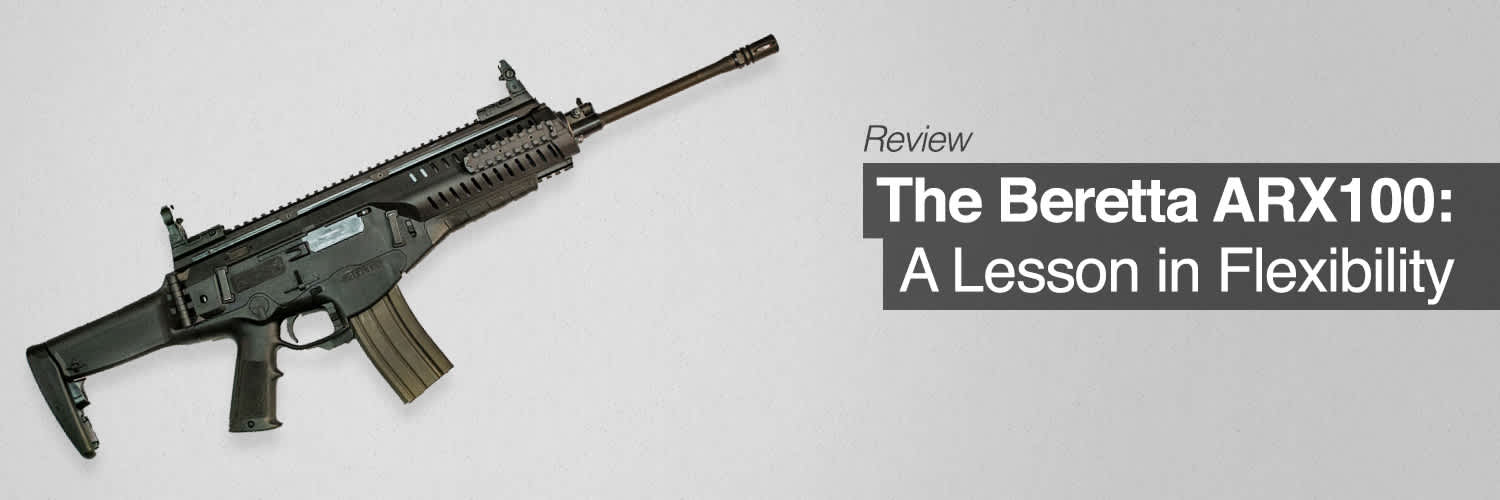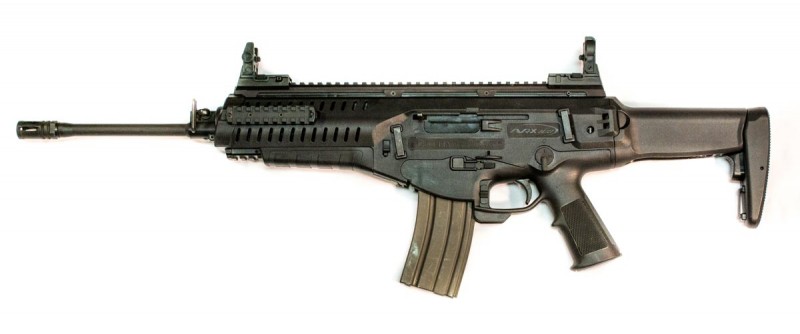The Beretta ARX100: A Lesson in Flexibility
Tom McHale 09.10.14

There’s ambidextrous, and then there’s ambidextrous.
Some rifles have safety levers on one side, or at least a safety lever that can be relocated to the opposite side of the frame. Others might have a way to move the magazine release button or even the bolt release to the opposite side.
The Beretta ARX100 takes configuration flexibility to a whole new level.

I just got my hands on a sample unit of this rifle and have been shooting it, taking it apart, and shooting it some more. Rather than waste words here with the specs like weight and length—you can find those here, or in the right sidebar—I’ll focus on how this rifle operates and handles.
For starters, let’s take a look at the many components of what I think is the ARX100’s standout feature: flexibility.
Barrel
You can swap barrels on a standard AR-type rifle, it just takes some time.
On the Beretta ARX100 with its default 16-inch barrel, it takes very little time and no tools. Just move the bolt to the maintenance position (I’ll describe that in a minute), then pull two spring-loaded levers downward. The barrel and extension will release and pull right out the front of the stock. The gas piston assembly comes out attached to the barrel.

The process could not be easier. Unlike an AR-type rifle, you have complete and unobstructed access to the barrel and extension with all those nooks and crannies for easy cleaning. Wow. Impressive simplicity and functionality, too.
Seeing how easily the barrel assembly is removed, I was concerned about the ARX’s ability to hold zero after a swap. Hold that thought until we get to the shooting report.
Bolt handle
The bolt handle is side-mounted and completely ambidextrous. By default, it would be on the left side of the receiver for a right-handed shooter. Beretta has designed in a neat little trick to move it to the opposite side without the need for any disassembly or tools.
The bolt has a “maintenance” position about halfway back through its travel. When you pull the lever back to this point (marked on the receiver), you can then pull the handle about a quarter-inch straight outward. This position is used for a number of maintenance functions, one of which is reversing the bolt handle. Simply push the handle towards the muzzle, and it will rotate all the way through the inside of the receiver until it comes out the other side. That’s it. You now have a left-handed rifle.
Safety
The safety button resembles that of any AR-type rifle, except the lever is already on both sides of the receiver. The rotating levers are identical, so safety operation does not favor right- or left-handed shooters.
Bolt catch
There are only five ways to lock the bolt open on this rifle.
- An empty magazine will lock the bolt open when the bolt handle is retracted.
- The bolt release lever on the right-front of the trigger guard can be used to lock the bolt open.
- The bolt release lever on the left-front of the trigger guard can be used to lock the bolt open.
- A button on the bottom of the trigger guard can be used to lock the bolt open.
- You can retract the bolt to the maintenance position and pull the bolt handle outward. This will lock the bolt open in the maintenance position.

Bolt release
Bolt release is a bit more traditional, although the controls are in a new place. Unlike AR-type rifles, there is no bolt release on the side of the receiver. Instead, there are levers on both sides of the trigger guard that, when pressed down, release the bolt. You can use your trigger finger to release the bolt, or you can easily reach the opposite-side lever with your support hand thumb. An alternate fail-safe method is to retract the bolt handle a bit, then let it go.
Ejection
Just behind the safety levers are holes that contain a push rod that controls ejection. Using a bullet tip, push the rod until it clicks. You’ve just changed the ejection direction.

Stock
Like many other rifles, the stock offers multiple positions for changing the length of pull. Whether you want to shorten it for body armor use, heavy clothing in the winter time, or smaller-stature shooters, that’s easy.
Unlike AR-pattern rifles, which have a buffer tube extending into the stock, the piston operation means there is no buffer tube. The ARX100 features a hinge on the stock, allowing you to fold it along the right side of the receiver. The rifle will still fire with the stock folded. Of course, you lose the inherent stability of the shoulder stock, but in a pinch, you can shoot it like a large pistol.
Accessories
The ARX has rails, rails, and more rails. The entire top of the receiver is one continuous rail, not connected segments like an AR receiver with a railed handguard. There are four-inch rails at the 9 and 3 o’clock positions and an exposed 1-1/2-inch rail segment at the 6 o’clock position. Just behind the lower rail segment is a hand guard that pops off, exposing a proprietary rail segment for Beretta accessories like vertical foregrips.
The ARX100 also has multiple sling attachment points. A swiveling sling loop is mounted to the gas block that rotates to either side. Two sling attachments are located on each side of the receiver, and one more is on the butt stock.
Magazine release
Buttons are located in the same position on both sides of the receiver for magazine release. The ARX100 uses standard AR-type magazines.
Sights
The rifle comes with polymer flip-up sights that slide onto the top rail and lock into whatever position you want, again requiring no tools. The rear aperture sight has a six-position dial with different apertures to reflect point of impact at different ranges from 100 to 600 yards.

If you haven’t caught on yet, the main feature of this rifle is its insane configurability—without the need for tools. I would presume one of the main design goals was quick field adaptability for military and law enforcement units. Different-size shooters? No problem. Righties and lefties? No problem. Need to change to short or long barrel configurations in the field? No problem. Need to change calibers in the field, again without tools? No problem.
Shooting the ARX100
The feel of the rifle will surprise you. Looking at it, you might think it’s heavy due to its bulky shape. It’s not. In fact, it’s surprisingly light, weighing in at just 6.8 pounds. That’s a result of judicious use of polymer for non-load bearing components like the stock, grip, and fore end.
One of the first things I did at the range was shoot some 100-yard groups and then removed the barrel. I let it cool and chill out for a few minutes, and then reinstalled the barrel and shot groups again. Contrary to my expectations, there was no discernible change in point of impact. Designing a barrel that pops off without tools while making it secure enough to maintain zero is quite impressive.
I could tell by looking that I was not this rifle’s first, and that other writers had it before me—mainly because it was pretty dirty. Therein lied the proof that gun writers don’t like to clean guns. Perfect. In addition to checking the point of impact after swapping the barrel, I tested a variety of ammunition types with the stock folded and unfolded configuration. There were no function problems with the few hundred rounds I shot.
After this outing, I brought the ARX100 home, removed the barrel, and proceeded to scrub the snot out of it before returning to the range for some accuracy testing.
On my next outing, I brought my BLACKHAWK! Sportster Titan III rifle rest and got to work with 100-yard distance, five-shot groups using a variety of .223 Remington and 5.56x45mm ammo. Here’s what I found:
| Ammo | Group size (inches) |
| American Eagle 55-grain FMJ | 2.3 |
| Black Hills 5.56mm 50-grain Barnes TSX | 1 |
| DoubleTap 55-grain Nosler Ballistic Tip | 1.02 |
| Freedom Munitions 55-grain FMJ, remanufactured | 2.42 |
| Hornady 55-grain V-MAX | 1.09 |
| IMI 5.56mm 77-grain OTM, LR, Mod 1 | 2.76 |
| Winchester Ranger 69-grain Match HPBT | 2.98 |
I tested a couple of handloads in a less formal fashion, all of which used 77-grain Sierra MatchKing projectiles. From my limited ammo testing, it would appear that the Beretta ARX100 prefers lighter bullets. This surprised me as the barrel features a 1:7-inch twist rate, which would imply it would do a great job with longer and heavier projectiles. I can only guess why it doesn’t play as well with heavier bullets, perhaps it has something to do with the removable barrel mount. In any case, I have found the IMI 77-grain OTM’s to be exceptionally accurate in other 1:7 twist rifles. It just goes to show the importance of trying different ammo types under controlled conditions to see what your particular gun likes. They all have preferences when it comes to ammo.

Closing thoughts
Like other service rifles, the trigger leaves something to be desired. I measured the pull at 8-1/2 pounds with virtually no take-up and negligible overtravel. Timney Triggers, are you listening?
I wasn’t sure what to expect in the accuracy department as it’s a gas-piston rifle, and therefore the barrel is not free floated. Based on my limited accuracy testing, it shot just fine, especially with 50- and 55-grain projectiles. Any service rifle that shoots in the one-inch group vicinity is doing a pretty good job.
The Beretta ARX100 is by far the most configurable rifle I’ve shot in recent memory. Neither configuration nor field stripping involved pins. The neat part is the clever design that allows almost all configuration to be done without tools of any kind. I’m not an engineer, but I imagine that takes some doing.
Tom McHale is the author of the Insanely Practical Guides book series that guides new and experienced shooters alike in a fun, approachable, and practical way. His books are available in print and eBook format on Amazon.
Images by Tom McHale

